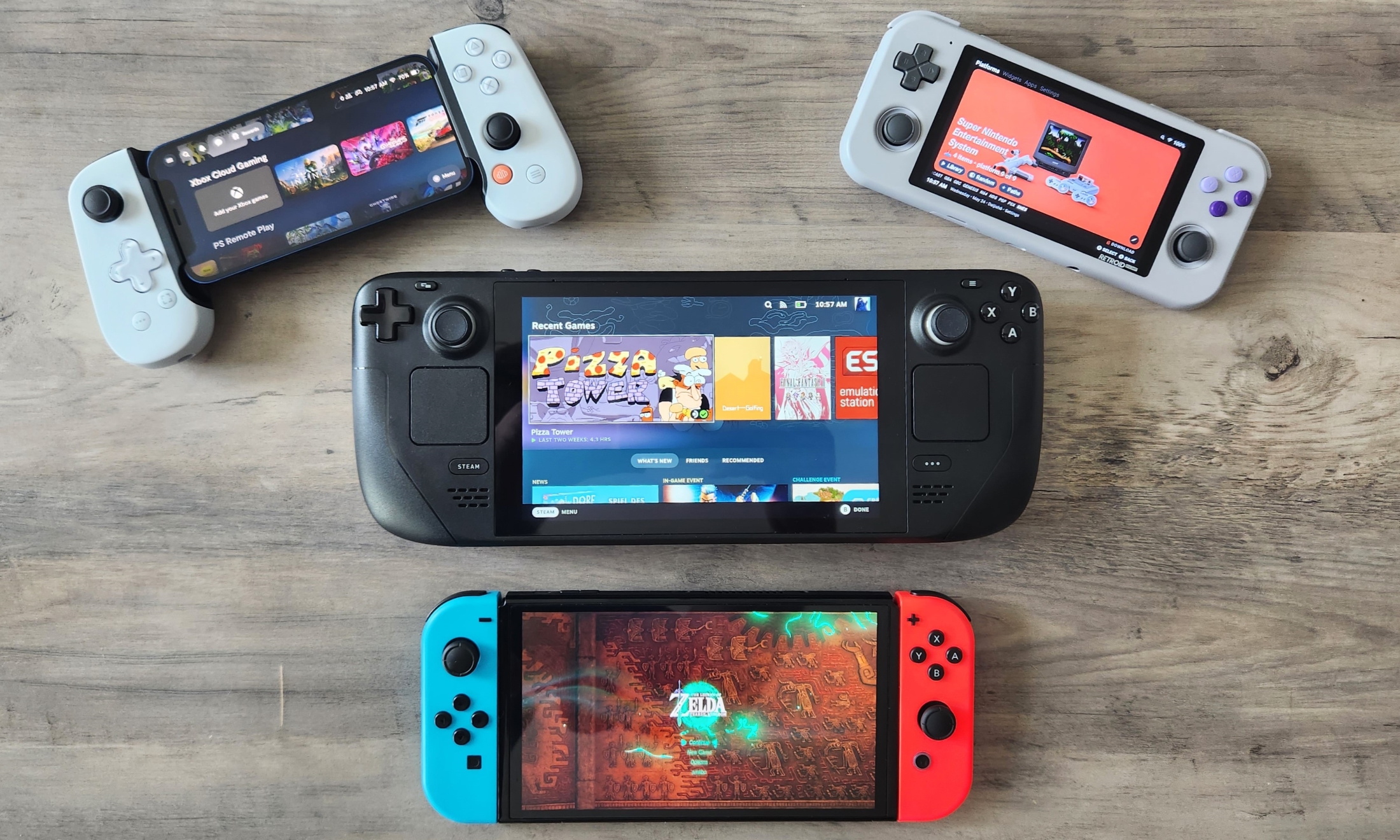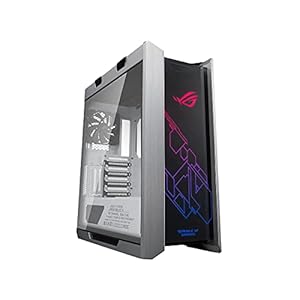
Handheld gaming programs are having a second. Whereas gaming on the go has been a factor for the reason that Recreation Boy, the success of the Nintendo Swap and a string of ever-improving processors have introduced an eruption of units that allow you to play all kinds of video games anyplace you need. As a result of new fashions appear to reach each week, nonetheless, determining the perfect gaming handheld for you may be difficult. You already know that the Swap is nice, however relying on what else you need to play, the correct handheld may vary from a $100 emulation machine to a $700 transportable PC. That will help you slim issues down, we’ve researched the perfect handheld gaming consoles, examined the most important contenders and laid out just a few high picks.
What to know in regards to the gaming handheld market
You may break down the gaming handheld market into three broad tiers. On the high, you might have x86-based transportable gaming PCs just like the Steam Deck or ASUS ROG Ally. These are probably the most highly effective handhelds you should buy, as they search to duplicate the expertise of a reasonably specced gaming desktop. The Steam Deck runs on the Linux working system, however most others use Home windows. If you wish to play trendy, not too long ago launched PC video games on the go (and want one thing stronger than a Swap), that is the kind of system you’d get. They’ll additionally emulate the widest vary of retro consoles. They’re sometimes the biggest and most cumbersome units to carry, nonetheless, and their battery life may be brief. Naturally, they’re additionally the costliest, costing anyplace from $400 to greater than $1,000.
Additional down on the worth spectrum are “cellular handhelds” just like the Logitech G Cloud or Retroid Pocket. These units usually run Android or Linux and might vary from beneath $50 to $400-ish. They aren’t outfitted to play trendy console or PC titles, however they’re normally extra compact than a conveyable PC, and you’ll nonetheless use them for cellular video games and cloud streaming. Whereas most are marketed towards these ends, many players really purchase them to emulate basic video games by way of software program like RetroArch. Getting emulators to work can be complicated, and accessing the BIOS and ROM recordsdata required to play video games this fashion is legally murky. (Engadget doesn’t condone piracy.) Backing up recordsdata of video games you already personal for private use solely is taken into account extra defensible, although, so for {that a} cellular handheld generally is a extra user- and wallet-friendly method to play the classics anyplace. One of the best cellular handhelds can usually emulate video games into the sixth generation of consoles, although newer programs just like the Nintendo 3DS and even the Swap are additionally playable to an extent.
We’ll name the final tier “handhelds that do their very own factor.” This can be a catch-all for issues just like the Switch or Playdate: transportable units that run closely custom-made software program and goal to supply a singular gaming expertise. They aren’t essentially excellent for emulation or enjoying the most recent multiplatform titles; as an alternative, they usually have distinct recreation libraries. They may not have the widest attraction because of this (Swap excluded), however they’re usually simpler for much less tech-literate of us to simply decide up and use.
Finest handheld gaming PC for many: Valve Steam Deck
Due to a recent refresh, Valve’s Steam Deck continues to supply the perfect stability of value, efficiency and usefulness within the gaming handheld market. And the brand new Steam Deck OLED is an intensive improve over the unique. Beginning at $549 for 512GB of storage, this variant encompasses a 7.4-inch OLED show that’s brighter, quicker, barely greater and extra vivid than the 7-inch IPS panel on the now entry-level mannequin. The upper distinction and richer colours of an OLED display screen makes each recreation look higher by default, however this show additionally helps HDR, with considerably brighter highlights at its peak. The utmost refresh price has jumped from 60Hz to 90Hz as properly, which might help many video games look smoother.
As a result of much less power-hungry show, a extra environment friendly AMD APU and a bigger battery, the Steam Deck OLED additionally lasts longer than earlier than. No handheld can play resource-intensive “AAA” video games for too lengthy, however Valve says the brand new mannequin can run for 3 to 12 hours relying on the sport, whereas the LCD mannequin lasts between two and eight. A bigger fan retains issues cooler and quieter, and the chassis feels lighter. Efficiency is roughly the identical, although the OLED mannequin’s elevated reminiscence bandwidth might help it achieve a pair additional frames in sure video games.
All that mentioned, $549 is a giant funding. The entry-level Steam Deck, which makes use of a extra fundamental IPS LCD show however now comes with a 256GB SSD as commonplace, continues to be an unmatched worth at $399. Newer AAA video games are actually pushing their limits, however each Decks can run tons of video games that simply aren’t attainable on a Nintendo Swap, from Elden Ring to Final Fantasy VII Remake to the Resident Evil 4 remake. Whereas official recreation help is restricted to a subset of the Steam library, the checklist of officially verified and still-playable titles is very large, various and continuously rising. (There are workarounds to entry different storefronts as properly.)
A near-constant stream of updates has turned Valve’s SteamOS into a versatile but user-friendly platform. You’ll nonetheless must make tweaks every so often to get a recreation to run optimally, however the course of is normally simple. That energy, mixed with third-party instruments like EmuDeck, makes the Deck excellent for emulation as properly. Some PS3 and unique Xbox video games may be difficult, however nearly every little thing else works fantastically. You can too cloud stream Xbox video games with a little setup.
The Steam Deck’s greatest situation is its dimension: At two inches thick and practically a foot lengthy, it stretches the definition of a “handheld” system, even when the OLED mannequin is lighter by comparability. The LCD Deck can get heat and noisy pretty rapidly, too, and the d-pad on every system is considerably mushy. However the contoured grips on the again assist offset the majority, and each variations really feel sturdy, with responsive face buttons and triggers, easy joysticks and helpful twin touchpads.
Finest Home windows various: ASUS ROG Ally
If you happen to’re prepared to spend additional for extra energy, you may skip the Steam Deck and purchase a Home windows-based handheld as an alternative. The ASUS ROG Ally is the one that ought to work for most individuals, and it’s an honest various if you happen to’re prepared to commerce ease of use for a better efficiency ceiling. Consider it like a extra transportable gaming laptop computer.
Be aware that we’re particularly recommending the mannequin with an AMD Ryzen Z1 Excessive APU, which prices $700. ASUS sells one other model with a weaker Ryzen Z1 chip for $100 much less, however the energy drop-off there may be too nice. With the Z1 Excessive, the ROG Ally can play extra demanding video games at larger body charges and resolutions than the Steam Deck. In our review, we noticed fps beneficial properties of 15 to 25 % in AAA fare like Cyberpunk 2077 and Shadow of the Tomb Raider. Whereas the Steam Deck formally tops out at a TDP of 15W, the ROG Ally’s Turbo mode boosts its energy draw to 25W (or 30W when plugged in), letting it eke out extra frames. It’s not absolutely the fastest handheld, and the Steam Deck can really outperform it from time to time on the identical TDP, decision and graphics settings. However the ROG Ally has extra overhead going ahead, which is necessary if you happen to largely play graphically demanding video games.
The ROG Ally’s 7-inch LCD show isn’t as shiny or color-rich because the Steam Deck OLED, however it has a sharper 1080p decision and a quicker 120Hz refresh price. Most significantly, it helps variable refresh charges (VRR), which helps preserve the picture easy at the same time as a recreation’s body price fluctuates. Regardless of having a similar-size display screen, the ROG Ally can also be shorter, lighter and thinner than the Steam Deck OLED. That mentioned, it doesn’t include a case. And although the {hardware} isn’t as a lot of a brick because the Steam Deck, Valve’s handheld has extra pronounced grips round its again, which may nonetheless make it simpler to carry for these with massive palms.
The ROG Ally’s upgraded efficiency and sharper show come on the expense of battery life, nonetheless. That normally sits within the two- to four-hour vary, however it may be even much less with sure video games and better efficiency modes, considerably defeating the purpose of a “transportable” system.
As a result of it runs on Home windows 11, the ROG Ally can play video games from any gaming consumer, not only a number of Steam video games. If you happen to’ve constructed up libraries on shops like Epic, GOG, Itch.io or the Xbox app, you may entry them right here as you’d on every other Home windows PC, no particular workarounds required. For individuals who need to play Epic exclusives like Alan Wake 2 or Xbox Recreation Cross titles, it is a actual benefit.
However the greatest situation with all Home windows handhelds is the working system itself. ASUS has made more strides than most by turning its Armoury Crate software program right into a centralized settings hub and recreation library, however it’s nonetheless slapping a bandage on an OS that merely isn’t designed for this system class.
Whether or not a recreation works easily straight away can really feel like a crapshoot on a Home windows handheld. Generally the UI received’t scale correctly, typically you’ll need to spend a number of minutes twiddling with graphics settings and key bindings, typically you’ll need to alternate between navigating the OS with buttons and together with your fingers. I as soon as needed to hard-reset the ROG Ally after a driver situation saved the display screen from turning on.
ASUS reveals a useful seven-minute tutorial on how one can replace and use the ROG Ally upon first launching Armoury Crate, however the truth that it wants a seven-minute intro video within the first place is telling. No person will confuse the Steam Deck with a Swap, however it’s a lot easier to simply decide up and use than any Home windows various.
The ROG Ally has additionally had some troubles with high quality management. Most notably, a number of customers have reported issues with the system ejecting or outright killing their microSD playing cards, a difficulty ASUS has since confirmed. The system’s SSD is replaceable with a little legwork, nonetheless, so we suggest taking that route if you happen to want greater than 512GB of storage.
Finest finances handheld gaming system (for now): Retroid Pocket 3+
The $149 Retroid Pocket 3+ is an Android system with far much less energy than the Steam Deck or ROG Ally, so it could solely play trendy video games through cloud streaming. It additionally comes from a lesser-known Chinese language firm. However if you happen to primarily need a handheld to emulate older video games, it is a snug and fairly inexpensive means to take action.
A phrase of warning, although: Retroid announced two successors to the Pocket 3+, the $149 Pocket 4 and $199 Pocket 4 Pro, proper as we completed the most recent replace to this information. Neither system must be an enormous leap ahead, however they’ll feature extra highly effective chipsets, analog triggers, Hall effect joysticks and extra conveniently-placed menu buttons. The Pocket 4 Professional may very well be a very nice worth, as its MediaTek Dimensity 1100 chip and 8GB of RAM ought to let it emulate practically all video games from demanding machines just like the PlayStation 2 and GameCube. The Pocket 4 and 4 Professional went up for pre-order this week and can start delivery in mid- to late-January, so the overwhelming majority of individuals ought to maintain off on shopping for the Pocket 3+ now. We’ll replace this information as soon as we check the brand new units.
If you happen to completely can not wait, nonetheless, the Pocket 3+ is successfully the identical as its predecessor (the Pocket 3, which we praised in late 2022) however provides a quicker chip (the Unisoc T618) and extra RAM (4GB). It’s constructed like a smaller Nintendo Swap Lite: largely flat, however slim, gentle (235g) and never fatiguing to carry for lengthy stretches. The 4.7-inch contact show isn’t enormous, however it’s shiny and saturated, with a sharp-enough 750 x 1,334 decision and a 16:9 facet ratio that’s good for cloud streaming and emulating programs just like the PSP. (You’ll get borders with some older consoles, although.)
The {hardware} nonetheless has some quirks: The face buttons are just a little beady, the beginning and choose buttons are oddly positioned on the left-hand aspect and the triggers aren’t pressure-sensitive. The joysticks are on the shallower aspect, too, however they’re easy and correct. General, although, the Pocket 3+ is simple to hold and constructed properly for the cash.
The Pocket 3+ can emulate consoles as much as the Dreamcast and PSP vary comfortably, and also you’ll have few points if you happen to’re primarily seeking to play older video games from the SNES, PS1 and earlier. After firmware updates, the system’s efficiency has additionally improved to the purpose the place some PS2 and GameCube video games are not less than playable. That’s spectacular for the worth level — however once more, the Pocket 4 and particularly 4 Professional ought to carry a noticeable improve. You may nonetheless play most native Android titles and stream video games from a PC, Xbox or PS5, too. Battery life will depend upon what you’re enjoying however sometimes lasts an honest 5 to seven hours.
Retroid makes one other handheld known as the Pocket Flip that’s primarily the Pocket 3+ with a clamshell design. That one prices $10 extra and makes use of sliders as an alternative of joysticks. Retroid hasn’t introduced a follow-up but, so it’s nonetheless price contemplating if you happen to’ll follow lighter emulation and need a type issue that’s nearer to a Nintendo DS than a Swap Lite.
Finest cellular gaming handheld: AYN Odin 2
In case you have additional cash to burn on an emulation-focused machine, the AYN Odin 2 is the best possible retro gaming handheld you should buy proper now. This Android system runs on a Snapdragon 8 Gen 2 chipset, the identical processor you’d discover in recent flagship Android telephones. It begins at $300 for 8GB of RAM and 128GB of storage, which is dear when the entry-level Steam Deck helps you to play PC video games for simply $99 extra.
Nonetheless, amongst extra compact cellular handhelds, there’s actually nothing else that may supply this a lot efficiency on this value vary. The Odin 2 simply performed all PS2 and GameCube video games we examined at two to a few instances their native decision, whereas different programs just like the PS1, N64, 3DS and Dreamcast had been sometimes playable at a 3-4x upscale. It’s smoother than most with the notoriously difficult Sega Saturn, and it could even play many Swap video games (although Swap emulators on Android are nonetheless maturing).
It’s not simply uncooked efficiency, although — the Odin 2 can also be a refined piece of {hardware}. It’s not pocketable, however it’s a lot much less chunky than a conveyable PC and the ergonomic grips on its again make it straightforward to carry. Its d-pad, face buttons, triggers and joysticks all really feel nice. As a result of the sticks use Corridor impact sensors, they need to keep away from drifting points over time. Different touches like a fingerprint scanner, a devoted return button, a micro-HDMI out port and two customizable again buttons are good perks, too.
The 6-inch, 1080p touchscreen is stable and well-sized (although it could keep a bit too shiny in darker settings). Battery life is excellent: We received greater than eight hours of juice emulating programs just like the PS2, however that jumped over 20 hours with lighter duties. The system helps 65W quick charging as properly. Cloud streaming and native Android video games work simply wonderful, and since the entire thing runs on a frivolously modded model of Google’s OS, its inventory interface ought to really feel acquainted to most.
The bottom Odin 2 has been out and in of inventory, and we’ll control how shut the Retroid Pocket 4 Professional can get to it performance-wise for $100 much less. However for taking part in the classics or streaming trendy video games with out a hitch, the Odin 2 is hard to high proper now.
A premium system for classic transportable video games: Analogue Pocket
The Analogue Pocket is the ultimate Game Boy. Its vertical design is constructed like a modernized, premium model of Nintendo’s basic handheld, and it could even work with equipment just like the Recreation Boy Digicam. In comparison with the unique, although, the Pocket provides two additional face buttons, a pair of rear triggers, a microSD slot, a USB-C port and a chargeable battery rated for six to 10 hours of playtime. Most importantly, it has a beautiful 3.5-inch show that’s each backlit and extremely sharp (615 ppi) however may be set to appear like an previous Recreation Boy panel with totally different filter modes. The system also can output to a TV with an optionally available dock.
Not like the retro handhelds talked about above, the Pocket is designed to play precise cartridges, not simply ROM recordsdata. It really works with Recreation Boy, Recreation Boy Shade and Recreation Boy Advance video games by way of its cartridge slot, whereas video games from the Sega Recreation Gear are playable by way of an optionally available adapter. (Ultimately, one day, adapters for different programs just like the TurboGrafx-16 and Atari Lynx will arrive as properly.)
Like previous Analogue units, the Pocket makes use of field-programmable gate array (FPGA) motherboards to imitate its goal programs on a {hardware} stage. In follow, this implies the Pocket’s “emulation” of older titles is near-perfect, with a stage of responsiveness and visible faithfulness that software-based emulation can’t match. Pop in a Recreation Boy or GBA cartridge and you’ll primarily play it as supposed. That mentioned, due to a big post-launch update and an energetic consumer group, the Pocket also can run ROMs off a microSD card and thus play programs just like the SNES and Sega Genesis.
The Pocket isn’t low-cost at $220, and its shoulder buttons aren’t as crisp to press as the superb d-pad or face buttons. Nonetheless, when you’ve got a set of Recreation Boy, Recreation Gear or GBA video games, the Pocket is probably the most elegant method to play them, and it’s solely grow to be extra versatile over time. Its greatest flaw is that it’s hard to purchase — anticipate to attend just a few months for brand new orders to ship.
Honorable mentions
Lenovo Legion Go
The Lenovo Legion Go is a capable alternative to the ASUS ROG Ally if you would like a Home windows handheld with a bigger show. It additionally prices $700, runs on the identical Ryzen Z1 Excessive chip and gives an identical set of efficiency modes, however it has a mondo-sized 8.8-inch panel with a sharper 2,560 x 1,600 decision and a better 144Hz refresh price. It additionally borrows some concepts from the Swap, together with removable controllers and a built-in kickstand for taking part in video games in a “tabletop” mode. These controllers have touchpads to make navigating Home windows just a little simpler, one thing the ROG Ally lacks. Battery life is just a little higher than ASUS’ machine as properly.
But it surely’s nonetheless a Home windows handheld, and Lenovo’s software program tweaks aren’t as mature (but) as what ASUS has executed with Armoury Crate, so the UX usually feels half-baked. The jumbo design is bulkier and a half-pound heavier than the ROG Ally, so some will discover it too fatiguing to carry. Its followers are louder, too, and the show lacks VRR. Nonetheless, it is not a bad choice if you happen to’re dead-set on Home windows.
Miyoo Mini Plus
The Miyoo Mini Plus is way more inexpensive than the Retroid Pocket 3+ and comes with a well-built, Recreation Boy-style type issue that matches properly with older video games. Its 3.5-inch show actually pops for one thing within the $60 to $80 vary, its battery lasts so long as it must and it could emulate consoles as much as the unique PlayStation with out a lot situation. It runs Linux, so it’s extensively customizable, although it could require a little bit of tinkering to get it working optimally. Because it’s from a smaller Chinese language agency and isn’t out there at main retailers, nonetheless, it may be troublesome to really purchase.
Playdate
The Playdate, from app developer and Untitled Goose Game writer Panic, is a tiny yellow field with a 2.7-inch monochrome show, two face buttons, a d-pad and a bodily crank constructed into its aspect. We known as it a “cross between a Recreation Boy and a enterprise card” in our review, and it’s certainly extremely small at roughly three inches tall and 0.18 kilos. It has a devoted recreation library that largely consists of oddball indies, most of which concentrate on one or two core concepts as an alternative of attempting to stuff in as many mechanics as attainable. A pair dozen of these video games are bundled with the system, whereas others can be found through a built-in store or sideloading from outlets like Itch.io. It’s usually well-built, and its battery life is respectable at six to eight hours per cost.
At $200, it’s laborious to name the Playdate an important worth when it’s solely designed to play a number of area of interest video games. Its show isn’t backlit, both. However in a sea of units that attempt to be every little thing for everybody, the Playdate is admirably centered and low-key. If you happen to’re into smaller-scale fare and have some cash to play with, it’ll be a enjoyable toy. It might take just a few weeks to ship, although.
Anbernic RG405M
The Anbernic RG405M is an efficient Android handheld if you happen to like the concept of the Retroid Pocket 3+ however need one thing extra compact. This system runs on the identical chipset however has a 4-inch show and a extra substantial steel body. Its 4:3 facet ratio means you received’t need to cope with black bars as a lot for retro video games, although it could really feel crunched with newer programs and cloud streaming. It’s dearer than the Pocket 3+ and upcoming Pocket 4, nonetheless, with costs beginning round $160.
We’ll additionally word the Retroid Pocket 2S, one other 4:3 handheld that begins at $99. It’s a pleasant compromise if you happen to’re on a tighter finances, however that decrease price brings a smaller 3.5-inch show, a barely slower chip and fewer premium construct high quality than the RG405M.
Different notable gaming handhelds we examined
The Ayaneo Kun is the most decadent Home windows handheld we’ve examined. With a pointy 8.4-inch show, a strong Ryzen 7 7840U chip, as much as 64GB of RAM, as much as 4TB of storage, an enormous 75Wh battery and a whopping 54W max TDP, it’s each a gaming beast and a possible substitute for a desktop PC. But it surely starts at $1,000, with a top-end config priced at an eye-watering $1,700. It’s additionally enormous, and it suffers from the standard Home windows-related points. It’s a brilliant system if cash is really no object, one with out a lot real competitors, however it’s extra handheld than most want.
The Ayaneo 2S is one other high-power Home windows handheld with a sharper show, bigger battery and extra configuration choices than the ROG Ally. It makes use of the identical chip because the Kun as properly. But it surely’s restricted to a 60Hz refresh price and prices just a few hundred {dollars} extra.
The Anbernic RG35XX Plus is one other wallet-friendly vertical handheld price keeping track of. For about the identical value because the Miyoo Mini Plus, it gives a quicker chipset, extra RAM and an even bigger battery alongside a equally spectacular design. It may simply supplant Miyoo’s handheld sooner or later, however it’s new, so it doesn’t have the identical useful firmware customizations proper now, and its inventory OS is fairly tough. Additionally, whereas its stronger processor is good, its small display screen and lack of analog sticks means you received’t need to emulate a lot past the PS1 anyway.
The Logitech G Cloud could be an important Android decide if it price about $150 much less. Its 7-inch 1080p show is shiny, vibrant and extra pleasing to take a look at than the panels on the Retroid Pocket 3+ or AYN Odin 2, its battery lasts a very good 10 to 12 hours per cost and its design is comfortable to carry for hours at a time. Alas, the G Cloud sells for $300, which is simply an excessive amount of when the Odin 2 gives much more energy for a similar value.
The PlayStation Portal is a baffling system that may solely stream video games from a PlayStation 5. It lacks built-in apps, so emulation isn’t attainable, and it could’t faucet into the cloud streaming service out there with a PlayStation Plus Premium subscription. As a result of it’s completely depending on the standard of your house Wi-Fi, we are able to’t assure how properly it’ll really carry out for you. It doesn’t work with Bluetooth earbuds, both. Its 8-inch show is ok and the DualSense-style controls are nice, so Sony diehards who need a second display screen for native PS5 streaming may even see the attraction. However there’s nothing right here that you may’t do with a smartphone and a mobile game controller, so most individuals are higher off saving their $200.
This text initially appeared on Engadget at https://www.engadget.com/best-handheld-gaming-system-140018863.html?src=rss
Trending Merchandise

















